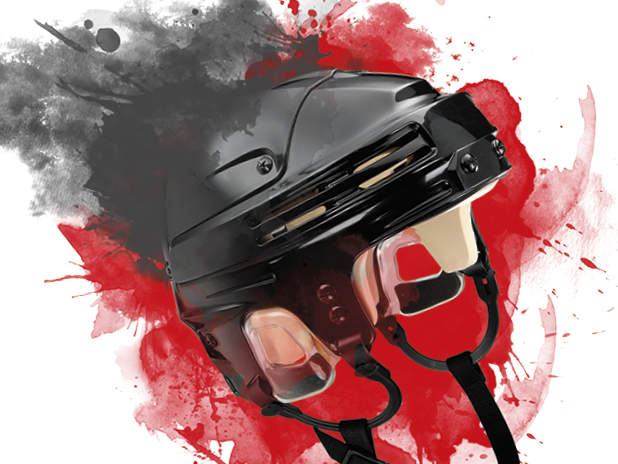Why The NHL Has To Address Its Concussion Crisis
FOLLOWING A 2012 MATCH in his hometown of Vancouver, Chicago Blackhawks defensemen Steve Montador was paid a locker-room visit by Charles Tator, a friend of his father and a leading voice in sports concussion safety who studies the brains of deceased pro athletes. “When I told Steve what I was doing,” recalls Tator, “he said, ‘If you want my brain one day you can have it.’”
The neurosurgeon never thought he’d have it so soon.
In February, Montador, 35, was found dead in his Mississauga home. His exact cause of death is still unknown (suicide has been ruled out), but Tator, director of the Canadian Sports Concussion Pro- ject, found evidence of chronic traumat- ic encephalopathy (CTE), a degenerative brain condition caused by repeated head collisions that can only be identified posthumously. He was the fifth NHL player diagnosed.
Professional boxing has dealt with its brain injury demons for decades. The NFL, after years of denying the dangers of concussions, is now facing its own crisis point, culminating in a $1 billion legal settlement and an Oscar-bait biopic about the neuropath who first discov- ered CTE in a football Hall of Famer. But for hockey, it took the tragic deaths
of retired enforcers like Montador to confront it head-on.
Following the NFL suit, over 200 former NHLers are currently suing the league over claims that it didn’t do enough to prevent and assess injuries, leaving them permanently brain damaged — with dizziness, irritability, impulsivity, impaired vision or dozens more symp- toms. “It’s the weirdest feeling,” says Mal Davis, a former Buffalo Sabre who scored the winning goal for the team’s greatest comeback victory, in 1983, and joined the class action suit 31 years later. “It’s like you’re drunk, it’s like you’re in a haze. I started having anxiety attacks, four or five of them in one year.”
Of course, one doesn’t have to be a professional to be affected. Research
by US health advocate Head Case has shown concussion rates in boys’ hockey are second only to football, and it’s on the rise in girls’ hockey, too. The tragedy of Ethan Williams, a 16-year-old WHL prospect, whose suicide his family blames on eight undiagnosed concus- sions, has only heightened parents’ wor- ries. “Most parents now understand it so well that they’re voting with their feet,” says Tator. Enrolment in youth leagues is tanking, and it’s not just because kids would rather play video games and Snapchat. Building a better helmet for the world’s 1.6 million organized hockey players may be the only thing that can protect the sport’s future.
IN A BRICK ROOM hardly bigger than a few penalty boxes, Brooklynn Knowles straps an automotive dummy with a black Bauer hockey helmet and cranks a handle until it’s lifted half a metre above a rubber and steel platform. She’s a bi- omedical engineer in one of the world’s few independent helmet research labs, receiving no funding from manufactur- ers. And while most have a varied focus, this one at the University of Alberta is almost entirely dedicated to hockey. “All of these helmets have been dropped on this platform,” she says, gesturing to stacks of them — for baseball, football, cycling and motocross — that nearly reach the ceiling. The majority, 58 in
all, were built for the ice, for colliding with the surface, the boards, the pucks, the sticks, the shoulders, the fists. And beneath the bone, the foam, the plastic, the brain shakes each time.
The question is at what velocity and acceleration does it shake too much, pushing through the cerebrospinal fluid, colliding with the skull and causing a concussion?
To answer it, she pulls a rope, the
lever drops, and the plastic crown slams into the platform. A shock-measuring system inside the dummy records the severity of the blow. It measures 40-G — or 40-times gravity. It’s well within the 300-G range to keep the shell intact and the skull from fracturing. But this isn’t about the durability of the helmet; it’s about the durability of the brain.
Few pieces of hockey equipment have evolved more than the helmet. Primitive headgear emerged in 1928, when the first professional player stepped on the ice wearing what looked like a leather basket on his head. But very few profes- sionals wore them. They were uncom- fortable, and they telegraphed weakness. Helmets evolved with plastic moulds and suspension systems that cradled the head, but negative perception persisted. The on-ice death of a Minnesota Stars player who landed on the back of his head, in 1968 — the league’s only one so far — barely shifted it. While helmets didn’t become mandatory for new NHL players until 1979 (a few players, like Craig MacTavish, resisted helmets until 1996), that death was a wake-up call for youth hockey teams, which instituted more stringent rules and called for the
development of better, safer headgear. In addition to optimizing comfort, visibility and ventilation, the helmet industry preoccupied itself with preventing skull fractures. That’s why, with rare excep- tions — such as the hairline fracture Mats Zuccarello of the Rangers suffered in April, leaving him literally speechless for days — you rarely hear about cracked skulls in the age of mandatory helmets for amateurs and professionals alike.
“The fact that we’re noting concus- sions in these athletes is a result of peo- ple surviving these head impacts — head impacts that may have otherwise killed them,” says Chris Dennison, director of the lab. Still, the sudden, intense focus on concussions has taken helmet-mak- ers by surprise. “Everybody’s criticizing helmets for something they weren’t designed to do. It’s like calling a car unsafe because it can’t stop a scud mis- sile. Nobody really knows what causes concussions.”
His team is trying to find the relative speeds, angles and rotations that corre- late with concussions — and they think they’ve come pretty close.
Knowles sits at a computer connect- ed to the dummy rig’s mess of wires.
Standing over her shoulder, Dennison asks, “Do you have one of your gigantic spreadsheets with your millions of data points?” She clicks a few icons and brings up two graphs, each with an upward diagonal line measuring a predictor of concussions called cumulative strain damage measure (CSDM). On one, the black dots representing thousands of helmet drops are all over the place. On the other, they follow the CSDM line.
The first one is the old measure, linear acceleration — when the helmet gets hit in a straight line. Of course, hockey doesn’t work that way. When two players collide or they whip their neck to avoid a puck to the head, the brain torques like a Jell-O bowl in an earthquake. That’s why they’re measuring rotational kinematics, and that’s where there is a clear and close correlation with CSDM. The faster the spin, the higher the CSDM number.
“If we could build helmets that limit rotational motions like angular accelera- tion and velocity, then helmets could be better at preventing concussions,” says Dennison. If manufacturers and existing standards organizations like CSA Group are willing to accept the science (and so far they’ve been slow to) they can test — and engineer — against these metrics. Meanwhile Dennison’s team is trying to design a methodology, and, down the road, a certification system for helmet makers to use that would also account for concussion risk.
One already exists: Virginia Tech’s STAR system (Summation of Tests for the Analysis of Risk), which has been embraced by the football industry.
Stefan Duma, a Virginia Tech biomechanics engineer, took 32 off- the-shelf hockey helmets to a rented rink, strapped them to a pendulum and slammed them against the ice and boards — then pummelled them with a levered hammer — 48 times each, in different directions and configurations. Duma found that some of the costliest helmets performed worse than the cheapest. He also found that not a single one of them performed well enough to earn five stars. Or four. And only one, made by Warrior Sports, got a three.
The vast majority of the helmets got one or no stars. Duma’s tests have been criticized by the helmet industry and other academics, saying his trials oversimplify the science. A player’s brain injury is as unique as his point rankings. The same hit that one player might shake off could cause memory loss in another. Many of the metrics Duma’s lab uses are also poor predictors of concussion, so scoring well on the star system doesn’t mean it will prevent them.
The criticisms echo what Duma heard in 2011 after inventing STAR for football helmets. But four years later there’s hardly a single manufacturer not designing five-star football helmets, nor an American high-school football team that will buy anything less than that.
“We’re expecting the same thing to happen in hockey,” says Duma, who worked in automotive and military engineering before turning to sports. He admits it’ll probably take longer for the hockey industry to adapt because its players, unlike football’s, buy their head- gear individually. What’s not lost on him is that his critics don’t deny the sport’s existing concussion problem. The STAR system is so far the only one to at least address the concerns of at-risk players and their parents.
THE SINGLE FACTOR that gave the best per- forming product three stars was about two inches of foam under the shell. Most others had about half that. But compare even the best of them with modern foot- ball headgear, which have two layers of shock-absorbing foam and padding, and it’s like comparing a Tempur-Pedic bed and a yoga mat. Duma says the Bauers, Reeboks and Eastons of the world will have to make a much bigger shell, add more padding and more shock absorption to earn a top rating.
“This is what fascinates me about hockey,” says Duma. “I bought a full hockey equipment set. From kneepads, to chest pads, hip pads, elbows and gloves, and there’s literally more padding on every other part of the body of a hockey player than there is on a head. You look like the Michelin Man, and you want to wear a smaller helmet?”
Dennison, however, argues that a weightier helmet comes with a trade-off: “You risk increasing neck injuries.” Others within the NFL have argued that bigger helmets have only encouraged bigger hits. “When you put a helmet on you’re going to use it as a weapon, just like you use shoulder pads as a weapon,” said Steelers receiver Hines Ward in a recent interview.
That echoes Charles Tator’s senti- ment, that the sport’s aggression is the real problem. His solution is one fans rarely want to hear, especially the one in flamboyant suits on Hockey Night in Canada — “no fighting, no intentional elbows to the head, no shoulders to the head, no Scott Stevens knockout blows.” He has at least one supporter in Mal Davis. “The game will be better,” says the retired player, whose lawyers are still in the deposition and discovery stages of the civil suit.
Unsurprisingly, countless sports fanatics have threatened Tator, told him to never leave the lab and accused him of trying to ruin the game. But he says science is trying save it. “We are way behind in figuring this out.”










